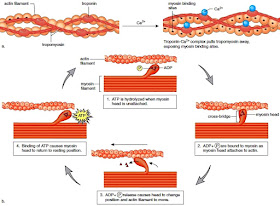The basic physiology of muscle contraction include (the numbering may not coincide with the image given below)
In a resting muscle, Tropo-myosin covers the
actin’s binding site for myosin.
2 When cytosolic calcium increases after the
opening of Sarcoplasmic Ca++ channel following the action potential, Free calcium
binds with the Troponin –C.
3 Calcium binding to Troponin C exposes the
Mysoin- Binding site in the actin.
4 The binding of actin and Mysoin occurs and Myosin pulls the actin towards itself
producing active tension. ATP is not needed for Cross bridge linking.
5 The
dissociation of actin and myosin is energy dependent. ATP
is needed for this release of actin myosin bond.
Once the dissociation occurs, the ATP is
hydrolysed to form ADP and Inorganic phosphate and the myosin is put back to
the high energy state with high affinity for actin being ready for next cycle of cross bridging.
 |
| Steps of Skeletal Muscle contraction Source:http://studylib.net/doc/9410005/steps-of-a-muscle-contraction |
Lets us take a
special Consideration on the point no 5 (not from diagram). The release of actin from myosin needs
ATP is the most important thing to describe physiology of post mortem rigidity.
Immediately after the death, the inherent tone of the muscle
is lost and the initial state of flaccidity is seen known as the stage of Primary Flaccidity. In this stage, the
somatic death has occurred but not the cellular death. So, the cell responds to
electrochemical stimuli.
Once death occurs at the cellular level, the membrane permeability to all ions are disrupted
and large amount of calcium is released
from the sarcoplasmic reticulum causing the binding of actin and myosin which brings about the contraction.
This is the stage of Rigor Mortis
and the cells no longer respond to electro-chemical stimuli.
The separation of
actin from myosin need ATP which is depleted
once the cell dies. So they cannot separate and hence the muscle remains
contracted.
After several hours of death, the autolytic enzyme released
from the lysosomes gradually degrade all the proteins including actin and myosin
causing the loss of stiifness after 15-20 hours. And hence the stage of Secondary Flacidity develops.
No comments:
Post a Comment